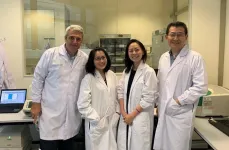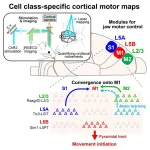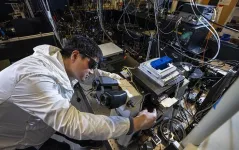(Press-News.org) Influencers are promoting “overwhelmingly” misleading information about medical tests on Instagram and TikTok, according to a global University of Sydney-led study published today in JAMA Network Open.
Researchers analysed almost 1000 posts about five controversial medical screening tests that had been promoted by social media influencers to almost 200 million followers. They found most posts had no reference to scientific evidence, were promotional, had explicit financial interests and failed to mention potential harms.
The tests included full-body MRI scans; genetic testing claiming to identify early signs of 50 cancers; blood tests for testosterone levels; the anti-mullerian hormone (AMH) test which surveys a woman’s egg count; and the gut microbiome test. Experts say these tests have limited evidence of benefit in healthy people and could lead to overdiagnosis and overuse.
“The vast majority of these posts were overwhelmingly misleading,” said Dr Brooke Nickel, who led the research from the Faculty of Medicine and Health’s School of Public Health.
“They are being promoted under the guise of early screening, as a way to take control of your own health. The problem is they are unnecessary for most people and, in some cases, the science backing their efficacy is shaky,” Dr Nickel said.
The study found 85 percent of the posts did not mention any test downsides or risks. “These tests carry the potential for healthy people to receive unnecessary diagnoses, which could lead to unnecessary medical treatments or impact mental health,” Dr Nickel said.
“One example is the ‘egg timer’ or AMH test. It is being heavily marketed to women by influencers as a way of measuring fertility, but experts do not consider it to be reliable. There is the concern that a low result discovered outside the context of a specific medical issue may drive some women to unnecessary, costly fertility interventions,” she said.
“Another example is the testosterone test, often marketed to men using fearmongering tactics to then promote testosterone supplements which claim to enhance masculinity and sexual performance. This is risky as the long-term safety of testosterone replacement therapy on cardiovascular health and mortality is still unknown.
“One of the underlying themes being used by influencers promoting these tests is that knowledge is power, but most information is cherry picked. When it comes to health, getting the full picture is so important, and half-truths are often lies.”
Among the 982 posts on Instagram and TikTok:
87 percent mentioned benefits of the tests, yet only 15 percent mentioned potential harms;
Only 6 percent mentioned the risk of overdiagnosis or overtreatment;
Only 6 percent mentioned scientific evidence, while 34 percent used personal anecdotes to promote the test;
68 percent of influencers and other account holders had financial interests in promoting the test (e.g. partnership, collaboration, sponsorship or selling for own profit in some way).
Co-researcher Dr Ray Moynihan, an Honorary Assistant Professor at Bond University, said: “These findings suggest social media is an open sewer of medical misinformation.
“This is a public health crisis that exacerbates overdiagnosis and threatens the sustainability of health systems.”
A detailed analysis of the results found that posts from medical doctors, posts mentioning scientific evidence, and posts from influencers with no financial interest in the tests, tended to be more balanced overall.
The research group is currently investigating ways to better regulate this type of misleading medical information on social media.
“Given that social media platforms like Instagram are moving away from fact-checking their content, the need for stronger regulation to prevent misleading medical information has gained urgency,” said Dr Josh Zadro, senior researcher and co-author from the University of Sydney.
5 common controversial tests in Instagram and TikTok posts
Test
Benefits and Harms
Full-body MRI scan
Claimed to test for up to 500 conditions, yet no evidence of benefit for healthy people, while real dangers exist of unnecessary diagnoses and overtreatment.
Multi-cancer early detection tests
Claimed to screen for more than 50 cancers, yet clinical trials are still under way. As yet, there is no evidence that benefits of screening healthy populations will outweigh harms of unnecessary cancer diagnoses.
AMH or “egg-timer” test
While beneficial for certain women, this test is falsely promoted to healthy women as a test for fertility, with concerns results can lead to unnecessary, costly fertility treatments.
Gut microbiome test
Test promises “wellness” via early detection of many conditions – from flatulence to depression – without good evidence of benefit, alongside concerns that test results could lead to medical overuse, causing harm and waste.
Testosterone test
No evidence of benefit for testing healthy men, yet danger of overuse of treatments; long-term safety of testosterone therapy, in relation to adverse cardiovascular events and early death, has not yet been established.
Declaration
Brooke Nickel and Emma Grundtvig Gram are current members of the International Scientific Committee of Preventing Overdiagnosis. Brooke Nickel, Tessa Copp and Joshua Zadro are funded through an Australian National Health and Medical Research Council Emerging Leader Research Fellowship (1194108, 2009419, and 1194105).The funders had no role in the design and conduct of the study; collection, management, analysis, and interpretation of the data; preparation, review, or approval of the manuscript; and decision to submit the manuscript for publication.
END
Influencers promoting ‘overwhelmingly’ misleading information about medical tests on social media
2025-02-26
ELSE PRESS RELEASES FROM THIS DATE:
Two papers by Walhout lab in Nature highlight novel metabolic principles
2025-02-26
Two papers published today in the journal Nature describe a significant advance in understanding the complex functions of the metabolic network. The research is from the lab of Marian Walhout, PhD, the Maroun Semaan Chair in Biomedical Research and chair and professor of systems biology, which has been engaged with fundamental questions of metabolism for more than a decade.
According to Dr. Walhout, organisms constantly monitor their nutrient intake and adjust their metabolism to generate biomass and energy; their ...
Multiplexing entanglement in a quantum network
2025-02-26
Laying the groundwork for quantum communication systems of the future, engineers at Caltech have demonstrated the successful operation of a quantum network of two nodes, each containing multiple quantum bits, or qubits—the fundamental information-storing building blocks of quantum computers.
To achieve this, the researchers developed a new protocol for distributing quantum information in a parallel manner, effectively creating multiple channels for sending data, or multiplexing. The work was accomplished by embedding ytterbium atoms ...
Bacteria consumed by immune cells become part of the cell
2025-02-26
Immune cells that eat bacteria in the body don’t stash them in specialized compartments as once thought, but turn them into critical nutrients that build proteins, create energy and keep the cells alive, according to a new study from scientists at the University of Colorado Anschutz Medical Campus.
“We are what we eat,” said the study’s co-senior author Angelo D’Alessandro, Ph.D., professor of biochemistry and molecular genetics at the University of Colorado School of Medicine at CU Anschutz. “What we eat changes the composition of us and when immune cells eat bacteria the same thing happens to them.”
The ...
CSIC researchers discover how the brain builds sophisticated maps to navigate and remember the world
2025-02-26
The brain creates internal 'maps' to help us navigate and learn from our surroundings, but how these maps form remains a challenge to understand. Now, a study led by Liset M. de la Prida at the Cajal Neurosciences Center (CNC-CSIC) in Madrid, in collaboration with Imperial College London, offers a fresh perspective on how spatial and experiential information is encoded in the hippocampus, a key brain region for navigation and memory.
The study published today in Neuron, reveals that two types of hippocampal ...
New spatial mechanism for the coexistence of tree species
2025-02-26
The data sets are very large: with more than 75 permanent forest dynamics plots in 29 countries worldwide, the Forest Global Earth Observatory network (ForestGEO) of the Smithsonian Tropical Research Institute (STRI) provides excellent forest inventories for investigating the dynamics of forest ecosystems and better understanding the processes that drive the structure and function of forests. On these 20-to-50-hectare plots, every single tree with a diameter not much larger than a pencil has been identified, measured and mapped every five years, often totalling more than 200 000 trees. The two UFZ researchers, Dr. Thorsten Wiegand ...
City of Hope research features myeloma study, cancer surgery and more
2025-02-26
This roundup highlights a common drug that can help treat multiple myeloma, a paper analyzing the benefit of a colorectal surgery follow-up test, recommendations for implementing remote patient monitoring for care received before, during and after surgery, details on how often women with an elevated breast cancer risk are receiving enhanced screenings, and clinical trial results for a new chimeric antigen receptor (CAR) T cell therapy targeting B cell acute lymphoblastic leukemia.
To learn more about research at City of Hope, one of the largest and most advanced cancer research and treatment organizations in the U.S. with its ...
A*STAR spin-off NalaGenetics implements nationwide drug reaction screening for leprosy patients in Indonesia
2025-02-26
SINGAPORE – NalaGenetics, a spin-off from A*STAR Genome Institute of Singapore (A*STAR GIS), will be transforming leprosy treatments in Indonesia with a nationwide genetic screening programme with their PGx1301 diagnostic kit. Set to launch in the fourth quarter of 2025, this initiative builds on a successful five-year pilot test in East Indonesia, which demonstrated the effectiveness of precision medicine in preventing life-threatening adverse drug reactions (ADRs).
As part of this programme, up ...
Unraveling the brain’s hidden motor modules
2025-02-26
For nearly a century, scientists have known that different parts of the human brain’s cortex control different body movements. This fundamental discovery dates to the 1930s, when neurosurgeons used electrical stimulation to map how different cortical regions correspond to different body parts.
But can these regions be further broken down into even smaller functional components? Researchers have long suspected that cortical units for specific body movements are more complex than simple patches in the cortex. Studies have identified various types of neurons stacked in multiple layers across the neocortex, but without a clear picture of how these ...
New photon-avalanching nanoparticles could enable next-generation optical computers
2025-02-26
A research team co-led by Lawrence Berkeley National Laboratory (Berkeley Lab), Columbia University, and Universidad Autónoma de Madrid has developed a new optical computing material from photon avalanching nanoparticles.
The breakthrough – which the team published recently in the journal Nature Photonics – paves the way for fabricating optical memory and transistors on a nanometer size scale comparable to current microelectronics. This approach offers a path toward realizing smaller, faster components for next-generation ...
Current status and future perspectives on early detection and diagnosis of colorectal cancer in China
2025-02-26
Colorectal cancer (CRC) is the second most commonly diagnosed cancer in China and a leading cause of cancer-related mortality. Despite improvements in treatment, the survival rate remains lower than in Western and other Asian countries due to late-stage diagnosis. Given that CRC typically develops over a prolonged period from precursor lesions, early detection and timely intervention are crucial for improving patient outcomes. However, CRC screening in China faces several challenges, including regional disparities, economic constraints, and limited public awareness. Recent advancements in non-invasive diagnostic tests, innovative imaging techniques, and ...





